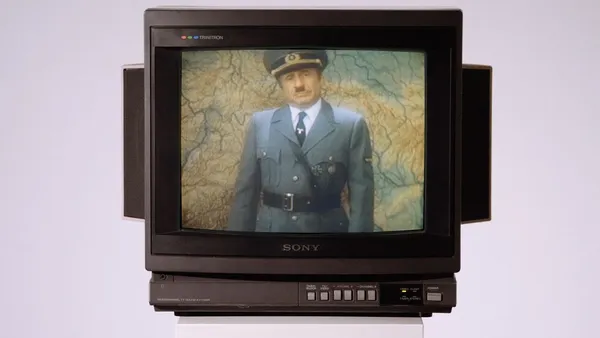Eye For Film >> Movies >> The Meaning Of Hitler (2020) Film Review
The Meaning Of Hitler
Reviewed by: Anne-Katrin Titze

Petra Epperlein and Michael Tucker’s ever more timely The Meaning Of Hitler, a DOC NYC highlight (executive produced by Marie Therese Guirgis, Jeffrey Lurie, Anthony Dobkin, produced by Mike Lerner, Dana O’Keefe, associate produced by Matilda Tucker, Susan Norget), features Saul Friedländer and Francine Prose on Leni Riefenstahl’s Triumph Of The Will, Martin Amis on political tactics and characterology, Klaus Theweleit on strangers, Deborah Lipstadt, Beate Klarsfeld, Serge Klarsfeld, Ute Frevert, and Yehuda Bauer. The filmmakers start in 2017 with a commuter train ride into New York City, and then on to a subway - Epperlein is seen reading books that mark the moment by the likes of Timothy Snyder, Hannah Arendt, George Orwell, Theweleit, and the one by Sebastian Haffner that gives the film its name.
A little avalanche of movie clips, from Mel Brooks’s The Producers to Bruno Ganz in Oliver Hirschbiegel’s Downfall, shows that “Hollywood has always loved Hitler”, which leads to Riefenstahl’s Triumph of the Will, a film that Prose calls “performance art”, “pure kitsch”, “gorgeous pageantry”, pointing to the formations which she compares to The Rockettes at Radio City Music Hall.

Historian Saul Friedländer calls it “a performance for eternity.” In other words, this was the Nazis’ goal - their festooned self-portrait (with the horrors expunged) taken for truth in the future, “propaganda repackaged as reality.” The Meaning of Hitler does not add to the propaganda, quite the opposite, it exposes it.
The brilliant use of the clapboard grounds us in time and subject matter, sometimes in place. There are many different “guided tours”, each one tying the images of now to information or points of view about the past. I was reminded of Claude Lanzmann walking through the present of Theresienstadt in The Last Of The Unjust and how the spirit of place could be made palpable even on film.
Martin Amis gets the first word on camera about how Hitler “resists understanding” and he explains some of the tactics used: ”You undermine the institutions of the state because that magnifies your own position. Everything is dependent on you.” His own novel Time’s Arrow is a fascinating take on revisiting history, with time moving backwards. The documentary’s car rides, shot through the windshield showing the Mercedes hood ornament, let us revisit historic places in the present.
During a tour conducted by Enno Lenze, director of the Berlin Story Bunker, set in a recreation of the Führerbunker in Berlin, he bemoans that “you have to explain to the kids what war is, what a bunker is.” This is followed by some very interesting juxtapositions in the editing. We see a clip from the 1981 TV movie The Bunker, with Anthony Hopkins as Hitler and Susan Blakely as Eva Braun, while a forensic scientist in the film talks about the remains found. The voice-over then goes a step further, to the observation that Hitler’s suicide is always shown behind a closed door, a privilege the millions of victims do not get, “so his legend lives on”.
Appropriately, Deborah Lipstadt gets to be heard first, before we are taken on a tour with the mean-spirited Holocaust denier David Irving. A woman identified as the official Polish state guide (Jadwiga Korowaj) sings a bawdy song at the Wolf’s Lair, which is intercut with Irving looking on. The singer tries to provoke him. He remains stone-faced. In Treblinka, he is walking in the forest and along the tracks with his group, joking unashamedly until someone tells him, “You still got your microphone on”. This is documentary gold. Epperlein and Tucker let Irving expose himself in his greed for attention.
Lipstadt, who was famously unsuccessfully sued by Irving, talks about the doctors who “flipped”, and let patients starve early on in the regime in Germany in the Thirties. “This was done in the most advanced society with the active participation of those elements of society that we generally see as a counterweight to this kind of authoritarian genocidal regime.” Klaus Heyne, an expert on Neumann microphones reveals how the new technology at that time was used for rallies and radio broadcasts, which gave Hitler’s voice an enhanced raw emotional quality that had not been heard before by the German people.
Ute Frevert, author of Emotions in History - Lost and Found, describes the blueprint Hitler used: “He produced his environment that sustained him and that confirmed his quest for power through all kinds of mythologies, but also a kind of day-to-day consent.”
A trip to Hitler’s Austrian hometown Braunau, a 2015 immigration “hotspot”, explains and debunks the “stable myth” and leads to sociologist Klaus Theweleit (so happy to see him included) who sums it up perfectly: “People are mostly afraid of strangers where there are very few strangers.” Amis explains: ”It wasn’t an ideology, it was more like characterology.” He continues that it consisted of a rallying cry with a bullhorn, similar to how Haffner put it: ”Those of you who are willing to rob, cheat, beat, and kill people who’ve done you no harm, then gather around my flag.” This connects directly with Theweleit’s point about the secret: “The secret that he gives the people the feeling they will be allowed one day to do the killing they are filled with, they are fantasising.”
The journey goes on; to Vienna and a warehouse in Fort Belvoir (the one from Raiders Of The Lost Ark), to Munich and the Braune Haus location (we see a moustached cat (kitler) on a poster with Mein Kampf, advertising the George Tabori play of that name), to Obersalzberg.
Nazi hunters Beate and Serge Klarsfeld are interviewed in Paris and he echoes what the tour guide earlier on in the Führerbunker in Berlin said, namely that “young people don’t understand war.” He also says that “history has no precise direction.” This thread is taken up by Friedländer in Berlin, in a car, about to speak in front of the Bundestag on Holocaust Memorial Day in 2019, when he states that “memory moves in its own direction.” His eloquent and touching speech was delivered in German, the language of his childhood.
During the same car ride, Friedländer suggests that The Meaning of Hitler should conclude in Sobibór, because “that would put an end to the fascination.” In the forest that now grows where the extermination camp once stood, there is no audible bird song. “There are no birds” says Wojciech Mazurek, the archaeologist working there. This is the unknowable spot of the history which was to be erased from history. “This is the page never to be written” we hear, the death machine the Nazis wanted to keep secret from the world.
The film does not end there, but moves on to glimpses into the Internet abyss and what happens when it spills over beyond the screens: Halle and Charlottesville. Epperlein and Tucker’s kaleidoscopic investigation into the past and our future takes us on the road of history to the state of the world at this moment in time.
At a demonstration in Dresden, we hear an aggressive voice saying “lying pig”, appearing to ask the filmmakers which station they are from; the moment goes by very fast. The rampant violence, hostility, and rage are frightening. One of the most chilling moments of the film, though, is chilling because of its seeming banality: A shot of two boys on a school trip walking in the WWI trenches in Flanders, busy looking at their iPhones, completely removed not only from the past they are revisiting but also the very present of the time and place they are in. “You are here!” we want to shout at them. Then we hear a bang and startled, they both look up.
Yale history professor Timothy Snyder’s On Tyranny: Twenty Lessons From The Twentieth Century is the very first book we see in the film, and for good reason. History is key in his plea as much as it is for this documentary. Snyder writes “History allows us to see patterns and make judgements. It sketches for us the structures within which we can seek freedom … To understand one moment is to see the possibility of being the co-creator of another. History permits us to be responsible not for everything, but for something.”
The wonderful Yehuda Bauer, at the age of 94, gets the last word: “The Nazi ideas were acted out by people who were absolutely normal.” Hannah Arendt, of course, comes to mind again. We end up in an empty, COVID-ridden New York. A car is leaving the city. A drive on a dark road in America at night is the last shot. It ties back to the beginning. Books and thoughts and movement.
The Meaning Of Hitler is screening virtually now through Sunday, November 29 as a DOC NYC Encore pick.
Reviewed on: 22 Nov 2020














